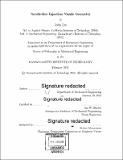Needle-free injection nozzle geometry
Author(s)
Liu, John (John Hsiao-Yung)
DownloadFull printable version (22.52Mb)
Alternative title
NFI nozzle geometry
Other Contributors
Massachusetts Institute of Technology. Department of Mechanical Engineering.
Advisor
Ian W. Hunter.
Terms of use
Metadata
Show full item recordAbstract
The development of needle-free injection (NFI) delivery systems has become increasingly important because of the advantages it affords such as increased patient acceptability, enhanced occupational safety for health providers, safe disposal, and increased speed of mass vaccination in the face of pandemic influenza or bioterror emergencies. Jet injection, wherein drug is propelled at high pressure through a narrow orifice to create a high-speed fluid jet sufficient to penetrate tissue, is one of several needle-free methods for administration of drug. Despite promising research and development, few efforts study the fluid dynamics of NFI and address the role of nozzle design. This thesis presents the development of nozzle geometries and the optimization of the nozzle shape for NFI applications. We develop nozzle geometries that produce non-axial jets to expand the range of NFI delivery modalities. A rigid, compact, multi-piece ampoule is designed and fabricated as a platform to conveniently house different nozzle inserts one at a time to offer increased jet consistency and functional flexibility. Two nozzle geometries that respectively produce radial jets and intersecting jets are designed and fabricated. Through high-speed imaging and injection into tissue analog and ex vivo porcine tissue, we demonstrate the utility of these nozzles for a range of injection applications including intradermal, intratympanic, and traditional uses. The presented ampoule is more successful than a commercial jet injection ampoule in adhering to desired position and velocity trajectories and the energy efficiencies of jet ejections are compared. Using computational fluid dynamics, we explore how the geometric elements of nozzle shape affect viscous loss and cavitation within the nozzle, the jet's velocity field at the orifice exit, and nozzle wall structural integrity. These insights inform the creation of an objective function and a class of curves used for nozzle shape optimization. A novel nozzle manufacturing technique is developed using a combination of micro-drilling and sink electrical discharge machining to fabricate axisymmetric nozzle orifices. Optically clear planar nozzles are developed and fabricated to image and compare the cavitation within the interior of nozzles of different shapes. The optimized nozzle demonstrates at least a 7% increase in mechanical efficiency and a decrease in cavitation of two orders of magnitude from a commercial jet injection nozzle.
Description
Thesis: Ph. D., Massachusetts Institute of Technology, Department of Mechanical Engineering, 2018. Cataloged from PDF version of thesis. Includes bibliographical references (pages 155-158).
Date issued
2018Department
Massachusetts Institute of Technology. Department of Mechanical EngineeringPublisher
Massachusetts Institute of Technology
Keywords
Mechanical Engineering.